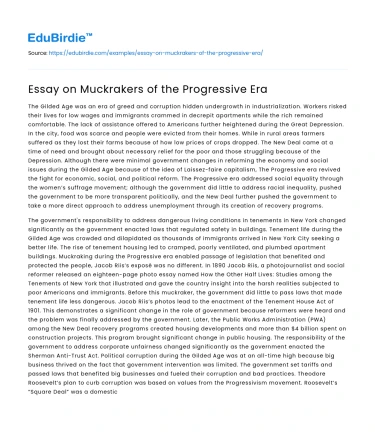The Gilded Age was an era of greed and corruption hidden undergrowth in industrialization. Workers risked their lives for low wages and immigrants crammed in decrepit apartments while the rich remained comfortable. The lack of assistance offered to Americans further heightened during the Great Depression. In the city, food was scarce and people were evicted from their homes. While in rural areas farmers suffered as they lost their farms because of how low prices of crops dropped. The New Deal came at a time of need and brought about necessary relief for the poor and those struggling because of the Depression. Although there were minimal government changes in reforming the economy and social issues during the Gilded Age because of the idea of Laissez-faire capitalism, The Progressive era revived the fight for economic, social, and political reform. The Progressive era addressed social equality through the women’s suffrage movement; although the government did little to address racial inequality, pushed the government to be more transparent politically, and the New Deal further pushed the government to take a more direct approach to address unemployment through its creation of recovery programs.
The government's responsibility to address dangerous living conditions in tenements in New York changed significantly as the government enacted laws that regulated safety in buildings. Tenement life during the Gilded Age was crowded and dilapidated as thousands of immigrants arrived in New York City seeking a better life. The rise of tenement housing led to cramped, poorly ventilated, and plumbed apartment buildings. Muckraking during the Progressive era enabled passage of legislation that benefited and protected the people, Jacob Riis’s exposé was no different. In 1890 Jacob Riis, a photojournalist and social reformer released an eighteen-page photo essay named How the Other Half Lives: Studies among the Tenements of New York that illustrated and gave the country insight into the harsh realities subjected to poor Americans and immigrants. Before this muckraker, the government did little to pass laws that made tenement life less dangerous. Jacob Riis’s photos lead to the enactment of the Tenement House Act of 1901. This demonstrates a significant change in the role of government because reformers were heard and the problem was finally addressed by the government. Later, the Public Works Administration (PWA) among the New Deal recovery programs created housing developments and more than $4 billion spent on construction projects. This program brought significant change in public housing. The responsibility of the government to address corporate unfairness changed significantly as the government enacted the Sherman Anti-Trust Act. Political corruption during the Gilded Age was at an all-time high because big business thrived on the fact that government intervention was limited. The government set tariffs and passed laws that benefited big businesses and fueled their corruption and bad practices. Theodore Roosevelt’s plan to curb corruption was based on values from the Progressivism movement. Roosevelt’s “Square Deal” was a domestic program that entailed the “Three C’s” (consumer protection, control of corporations, and conservation). Roosevelt witnessed the unfairness in big business and went after monopolies that didn’t pay workers fair wages. The President passed the Sherman Anti-Trust Act that outlawed “all restraint of trade”. The role of the government changed significantly because the President recognized the dangers of trusts and monopolies to the economy. Previous Presidents kept a “laissez-faire” approach to the economy and excluded the bad practices of corporations and capitalists. The role of the government was to address racial discrimination towards African Americans that ran rampant throughout the progressive era. The Progressive era mainly benefited white Americans while Black Americans were pushed to the side and had to deal with discriminatory policies. Southern states passed Jim Crow laws, these laws limited the rights of African Americans and treated them as second-class citizens. The “Nadir” of race relations during the time bred violence against Black Americans and lynchings. Ida B. Wells a journalist and muckraker wrote about race and political issues in the South’s articles that led to the development of the Anti-Lynching campaign. The government failed to pass any anti- lynching legislation in an era of social reform. In times of economic and political crisis, the government played a more direct and active role in fixing and helping the issue while progress in race relations remained stagnant because Black activists, liberationists, and citizens were ignored and their want to achieve racial equality was always pushed to the side.
Save your time!
We can take care of your essay
- Proper editing and formatting
- Free revision, title page, and bibliography
- Flexible prices and money-back guarantee
Did you like this example?
Make sure you submit a unique essay
Our writers will provide you with an essay sample written from scratch: any topic, any deadline, any instructions.
Cite this paper
-
APA
-
MLA
-
Harvard
-
Vancouver
Essay on Muckrakers of the Progressive Era.
(2024, February 09). Edubirdie. Retrieved December 22, 2024, from https://edubirdie.com/examples/essay-on-muckrakers-of-the-progressive-era/
“Essay on Muckrakers of the Progressive Era.” Edubirdie, 09 Feb. 2024, edubirdie.com/examples/essay-on-muckrakers-of-the-progressive-era/
Essay on Muckrakers of the Progressive Era. [online].
Available at: <https://edubirdie.com/examples/essay-on-muckrakers-of-the-progressive-era/> [Accessed 22 Dec. 2024].
Essay on Muckrakers of the Progressive Era [Internet]. Edubirdie.
2024 Feb 09 [cited 2024 Dec 22].
Available from: https://edubirdie.com/examples/essay-on-muckrakers-of-the-progressive-era/
copy






 Stuck on your essay?
Stuck on your essay?

